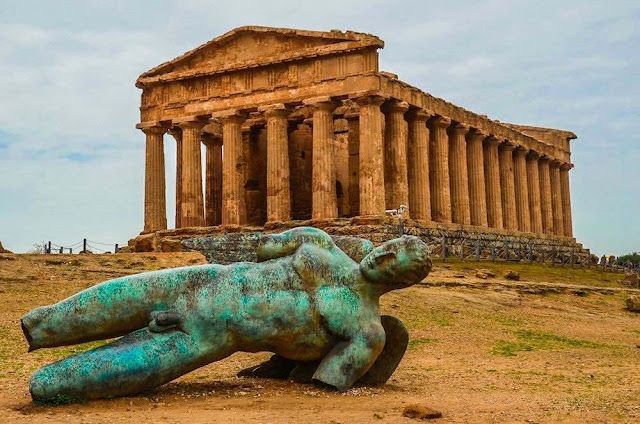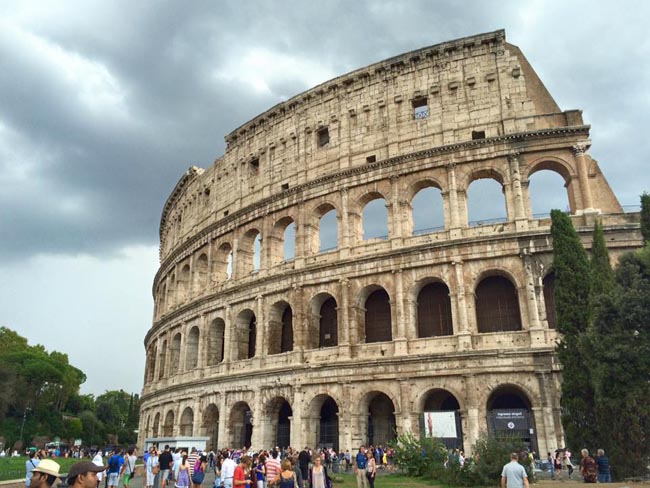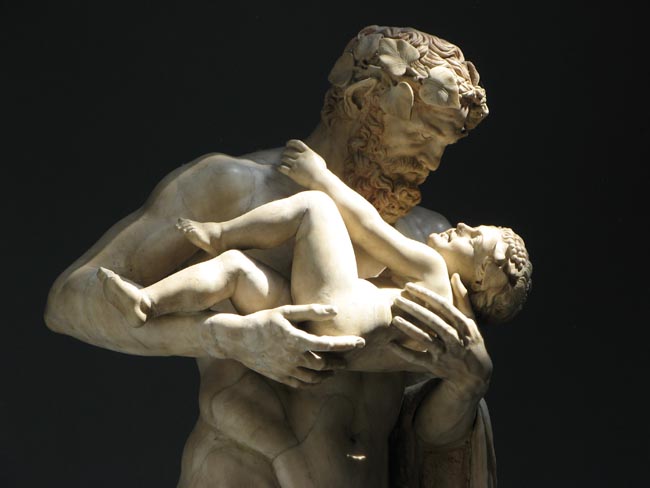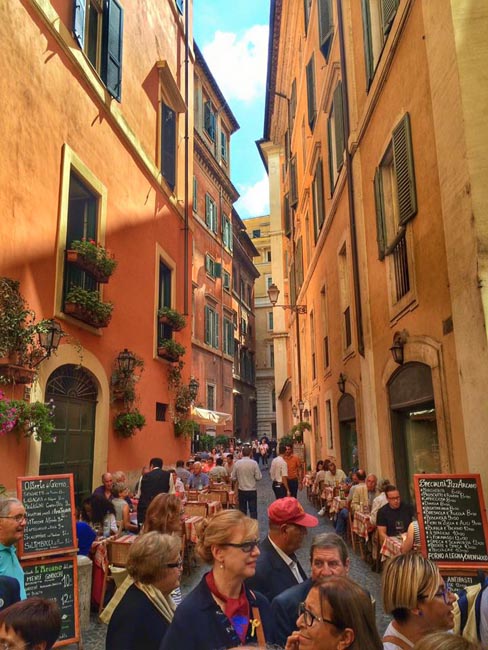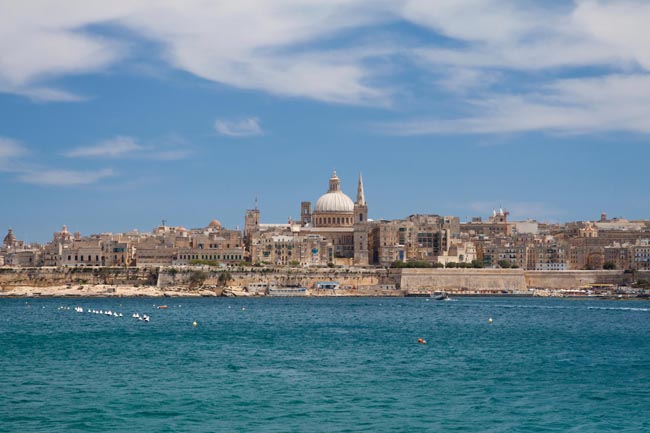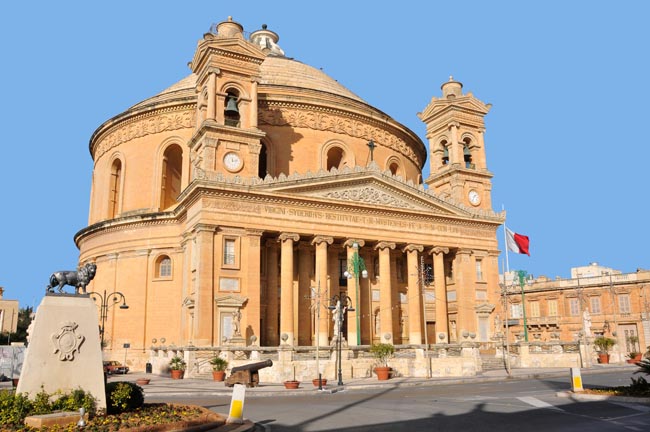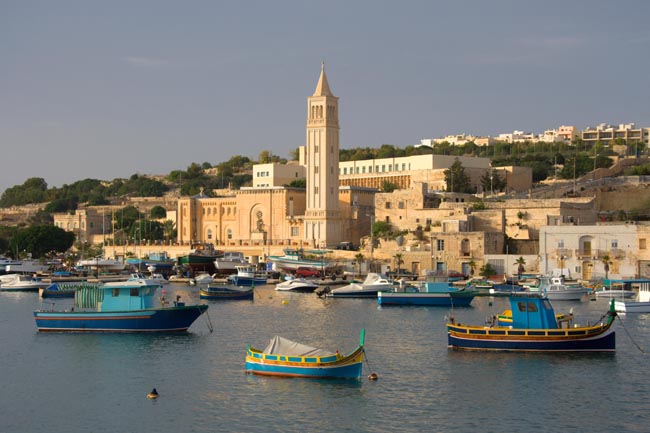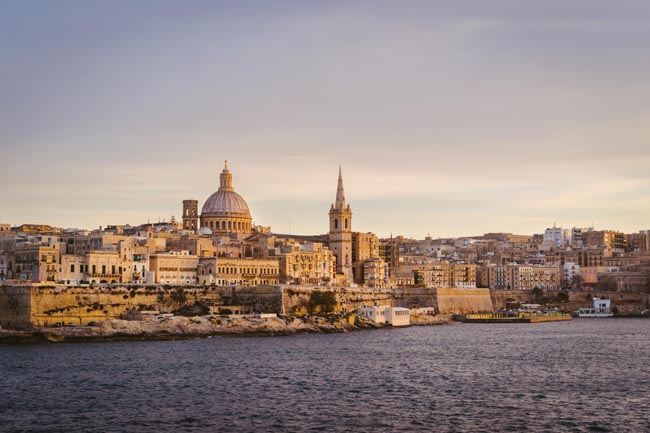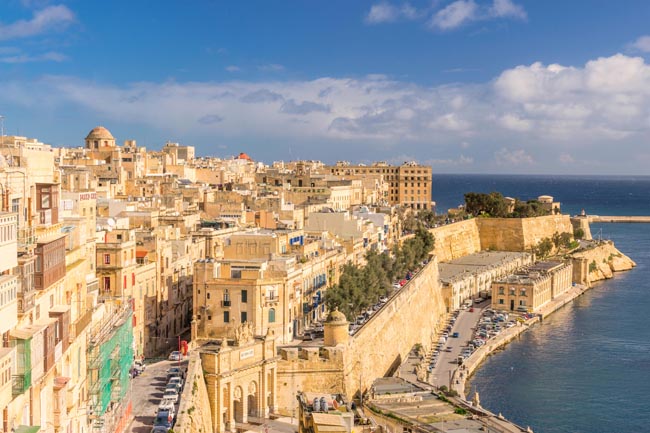Malta offers stunning beaches, a rich history, and friendly people. Explore ancient temples, sail with the Knights of St. John, and discover the beauty of Gozo. In Sicily, experience local markets, historical sites, and the wonders of Pompeii. Conclude your journey in Rome and the Vatican.
Prices below are per person, twin-sharing costs in US Dollars (USD). Pricing does not include airfare to/from the tour and any applicable taxes. For single supplement rates and taxes (if any), please refer to below Prices & Dates table. For general information on flights to/from the tour, click here.
Your Travel and Accommodation Arranged For You
Tips Included for Driver, Restaurant Staff, Local Guides
Authentic Local Experiences With Lots Of Inclusions.
Select a date below to reserve your spot:
The above prices are subject to an additional $105 for taxes/fees levied on flights that occur as part of the tour. The internal airfares ARE included (any exceptions are listed in red below), but we list the taxes separately on your invoice as they are beyond our control and can change at any time.
Optional Single Supplement: $1350 USD (number of singles limited).
Download Itinerary
Day 1 Arrive in Malta
Welcome to Malta!
Malta has a greater density of historic sights than any other country. Starting with its unique prehistoric temples, some of the oldest stone buildings in the world, it also has Roman catacombs, medieval towns, and the extraordinary architectural and artistic legacy of the Knights of St John (the Knights of Malta). The British left behind red letter boxes and phone booths, as well as the language, in spite of which Malta (independent since 1964) remains thoroughly Maltese. The country has thankfully shaken off the British culinary legacy and is home to some excellent restaurants specialising in Mediterranean food.
Overnight in Malta.
Included Meal(s): Dinner
Day 2 Valetta: City Tour & Dingli Cliffs
This morning we depart on foot for a full-day tour of Valletta, the capital of Malta.*
Valletta is arguably the smallest capital in Europe -- the entire city is only 1000m (1 km) long and 600m wide! Jean Parisot de la Valette, the Grand Master of the Order of the Knights of St. John, founded the city in 1566 following the Knights' defeat of the Ottoman Turks during the "Great Siege of Malta". Massive fortifications on the seaward side were built, and a defensive ditch on the landward side. The city inside the walls was then laid out on a regular street grid pattern, and adorned with churches, palaces, auberges (inns), and the famous hospital of the Knights, the Sacra Infermeria.
We start our day with a relaxing cruise around the two natural harbours on either side of Valletta, Marsamxett Harbour and the Grand Harbour. A detailed commentary will unfold the history of Valletta and the Three Cities connected with the two Great Sieges of 1565 and 1942, as well as the other places of interest including the historical forts, battlements and creeks which can only be admired from the seaharbours, creeks, shipyards, skylines and bastions of Valletta, and the "Three Cities" are unforgettable.
We then proceed to the Upper Barakka Gardens, with its magnificent views of the Grand Harbour, and the fortified peninsulas of Senglea and Vittoriosa. Next is the Grand Master's Palace, today the official residence of the President of Malta and the seat of parliament. The palace housed the residence and state rooms of the Grand Masters from 1571 until their expulsion by Napoleon in 1798. We will visit the State Apartments and the Council Chamber where the 17th century Gobelins tapestry are hung. We will also visit the Armoury, housed in the former stables of the Grand Masters; the armoury is the largest collection in the world of its kind. Thousands of suits of armour and a huge array of weaponry are to be seen here which either belonged to the Knights of the Order or were captured as trophies of war.
You will have free time to take lunch in one of the many sidewalk cafes and restaurants in Valletta. After lunch we will see the 45 minute film "The Malta Experience," an excellent audiovisual documentary providing a detailed overview of the history of the island, from prehistory to modern times. The film is screened in the 16th century hospital of the Knights of St. John -- the Sacra Infermeria -- famous throughout Europe for its sheer size and highest standards of care.
We finish our full day with a drive to the south coast of the island. We stop for the beautiful panorama at the 220m high Dingli Cliffs with its magnificent views of the cliffs and the offshore islet of Fifla. Just beyond, at Clapham Junction, are the remnants of mysterious "cart ruts" in the limestone from the Bronze Age. These are a series of deep, intersecting parallel ruts, probably carved by sleds rather than carts.
PLEASE NOTE: Malta's Hal Saflieni Hypogeum site and tour is a popular option should you choose to extend your stay outside of our tour. We do not include it in our program as the number of visitors per day is very limited and spaces tend to sell out before many/most of our travellers commit to our tour; as such, promising the visit in our itinerary is problematic. We suggest booking your own visit once our tour is 'guaranteed' to operate.
* Most of our tours are accommodated in St Julian's, a smaller seaside district located just to the north of Valetta.
Overnight on Malta.
Included Meal(s): Breakfast and Dinner
Not finding what you're looking for?
Our specialists can take away the stress and create a private custom tour tailored to your exact interests and budget.
Day 3 Valletta & Prehistoric Malta
We return to Valletta and begin the day with St. John's Co-Cathedral, the architectural gem of Malta. The church was built in the 1570's for the Knights of St. John, by the great Maltese architect Gerolamo Cassar, who also designed the Grand Master's Palace and many of the auberges of the Order. It is the masterpiece of Maltese baroque, with its rich interior decoration and paintings by the celebrated artist Mattia Preti (1613-1699). The impressive floor is paved with colourful slabs of inlaid marble, with ornate decorations and epitaphs marking the location of over 300 tombs below, including the tombs of the first 12 Grand Masters of the Order of the Knights. We will visit the Cathedral's Museum and Oratory, where hangs the masterpiece, 'The Beheading of St. John the Baptist' by Caravaggio. During his brief stay in Malta (1607-8), he was admitted (and soon expelled) from the order of the Knights, and commissioned to paint several works. 'The Beheading of St. John the Baptist' is the largest painting ever created by the artist, and the only one he ever signed.
From here we proceed to the National Museum of Archaeology, housed in an original Auberge, the residence of the division of Knights from Provence. Here we will get an overview of the prehistoric cultures, the first known inhabitants of the Maltese islands. On exhibition are the ancient artefacts of the mysterious megalithic temple builders -- dating as far back as the 4th millennium BCE.
We continue to south coast to Hagar Qim on the south coast. This temple dates to the Ggantija phase (3600-3200 BCE) and is spectacularly located on a hill overlooking the islet of Fifla. The prehistoric temples on the Maltese islands are the oldest surviving freestanding structures in the world; dating to the 4th and 3rd millennium BCE, they are 500-1,000 years earlier than the oldest pyramid built at Giza! Who were these mysterious people? Why and how did they build the temples? We also visit nearby Mnejdra Temple.
We drive to the picturesque village of Marsaxlokk set on a harbour of colourful traditional fishing boats. The boats are brightly painted in blue, yellow and red, with a vigilant eye on the bow to ward off evil, a tradition believed to date back to Phoenician times. Because most of the fishing boats of the island moor here, the Bay of Marsaxlokk has some of the finest seafood restaurants on the island.
PLEASE NOTE that on some tour dates, days 3 and 4 may be swithed around.
Overnight on Malta.
Included Meal(s): Breakfast and Dinner
Day 4 Day Trip to Gozo
This morning we head to the north-western tip of Malta to catch the ferry to the island of Gozo, which lies nearly 5km from the coast of Malta; the crossing takes only about 30 minutes. Gozo, pronounced "awdesch" in Malti, is about 1/3rd the size of Malta, 14 km long and 7km at its widest point. Gozo has its own distinctive characteristics and identity -- the Gozitans are proud of their traditions, lifestyle and dialects -- distinct from those of the main island. The island is more fertile, and economic activity is still based on farming and fishing; it is known for its magnificent landscapes, traditional villages and unspoiled coves.
We proceed to the prehistoric temples of Ggantija, one of the oldest and certainly the largest temple complexes of the Maltese archipelago, hence the folklore that they were built by giants. The largest megalith here is over 5m in length and is estimated to weigh over 50 tonnes! The two temples are surrounded by a monumental wall and date to the period 3600-3200 BCE, the same period as Hagar Qim.
We spend some time in the capital of the island, Victoria, inhabited since Neolithic times. The city encompasses both the imposing citadel, Il Kastell, perched on a high vantage point and dominating the landscape in all directions, and Rabat, the suburb outside the walls. Entering the main gate, we will explore the lanes and monuments of the citadel including its 17th century bastions, fortifications and the Cathedral of the Assumption. After a brief visit of the Archaeological Museum, we go to the Folklore Museum, a fine ethnological museum with exhibits dedicated to traditions and culture of rural Gozo. We will also wander the streets and colourful markets outside the walls.
Our last stop of the day is Dwejra for some the most spectacular coastal stretches of the island. Two huge underground caverns in the limestone collapsed to form what is today Dwejra Bay and the Inland Sea. We will take a relaxing boat trip, run by local fishermen to see the inland sea, a lagoon surrounded by cliffs which joins the sea via a 100m long tunnel through the headland of Dwejra Point. We will see the fantastic geological phenomena of the Blue Hole, and enjoy the panoramas of Dwejra Bay and Fungus Rock. The fungus (cynomorium coccineus) growing on the islet was exploited by the Knights of St. John for its wide array of curative properties. Indigenous to North Africa, but not found anywhere else in Europe, it was so valuable that the Knights built the nearby Qawra watchtower. Ferry back to Malta.
Overnight on Malta.
Included Meal(s): Breakfast and Dinner
Day 5 Mosta, Mdina & Rabat
Today is dedicated to the fascinating cities of the interior: Mosta, Rabat and Mdina.
Our first stop is the see the Rotunda Church in the city of Mosta, which dominates the landscape in all directions from its position on a plateau. Based on the design of the Pantheon in Rome, it is the 3rd largest unsupported dome in Europe after the Pantheon and St. Peter's Basilica in the Vatican. Built in the mid 19th century by a local architect and dedicated to the Virgin Mary, it has held a special place in the hearts of the Maltese because of the miraculous events of World War II. In June, 1942, three bombs were dropped on the church during mass; 2 fell in the square and one penetrated the dome -- but none of the three exploded.
One of the main highlights of the island is the ancient walled city Mdina, former capital of the island, and its suburb outside the walls, Rabat. Both have been inhabited since antiquity. In medieval times, Mdina was known as Citta Notabile where the Maltese aristocracy lived and which is reflected in the quiet dignity of its 17th century architecture and narrow shady lanes. We will stroll the peaceful streets, stopping to admire to the views from the city walls, the mansions of the nobility, the churches and Cathedral of St. Paul -- the seat of the Archbishop of Malta. You will have time to have lunch in one of the pretty cafes/restaurants.
Exiting the walls of the city through the Main Gate, we cross the moat to the suburb of Rabat. We stop first at the remains of the Domus Romana, a Roman townhouse with colonnaded courtyard and beautifully preserved mosaics. It is one of dozens of Roman villas which dotted the countryside around Mdina (Roman Melita). Here in Rabat is the Church and Grotto of St. Paul, where tradition says that he preached to the citizens of Roman Melita (Mdina) during his stay in Malta. According to Acts: 27-8, St Paul was shipwrecked on Malta on his way from Caesarea to Rome.
The governor Publius received him and gave him shelter for 3 months; he converted to Christianity, became the first bishop of Malta and was later canonized. We continue to see the series of interconnected Catacombs, the cemeteries which were dug into the rock outside ancient city walls. The two largest on the island are the so-called Catacombs of St. Paul and St. Agatha and date back to the 4th and 5th centuries. The most characteristic feature of these Paleochristian tombs is the mensa, or agape table surrounded by an inclined platform, for tomb visitors to partake in funerary feasts commemorating the dead. If the Catacombs of St. Agatha are not open, we will visit those of St. Paul.
Overnight on Malta.
Included Meal(s): Breakfast and Dinner
Day 6 Valetta, Malta - Palermo, Sicily, Italy
Today we fly to Palermo.*
Palermo is the capital of both the autonomous region of Sicily and the Metropolitan City of Palermo. The city is noted for its history, culture, architecture and gastronomy, playing an important role throughout much of its existence; it is over 2,700 years old. To gain an initial understanding of the city's unique culture, start by wandering the streets of the old city. The mix of architectural styles points to the wave upon wave of invaders who have claimed the city as their own, as does the look of the locals.
* Due to air scheduling considerations, we may elect to fly the group to nearby Catania instead of Palermo and transfer to Palermo from there (+/- 2 hours). For our purposes, Catania often has more convenient departure/arrival times.
Overnight in Palermo.
Included Meal(s): Breakfast and Dinner
Day 7 Palermo: City Tour
We begin our day with a walk through the narrow streets of the Il Capo outdoor market. Here we feel the very pulse of the city's daily life, passing stalls where fishmongers display whole sword fish and tuna, and several varieties of squid and octopus. Sicily is agriculturally rich and here some of the island's excellent produce is displayed: apples from the slopes of Mount Etna; oranges and lemons, introduced to Sicily by the Arabs; cactus pears, fresh figs and grapes, fat olives, fresh capers, zucchini blossoms, fresh ricotta and pungent pecorino cheese.
A short walk brings us to the Piazza Praetoria with its voluptuous 16th century Florentine fountain, decked with renaissance nudes and animal heads. At its unveiling, centuries ago, locales named it "the fountain of shame". Nearby is the baroque Quattro Canti, the 17th century crossroads that divides the old city into four, and the Municipio, a 15th century palazzo that is Palermo's city hall.
On the Piazza Bellini, we step inside the Martorana Church; a 12th century building that is a jewel of Arab-Norman architecture, and its interior encrusted with byzantine mosaics. And no visit to Sicily would be complete without a stop at Monreale, the Royal Mountain. It was here, at the end of the 12th century, that the Norman king, William II had a great cathedral built to reflect the sophistication and wealth of his kingdom.
We finish our day at the superlative Church and Monastery of Santa Caterina d'Alessandria, built as a hospice in the early 14th century and transformed into a Dominican convent the following century. This monastic complex wows with its magnificent maiolica cloister, surrounded by unique balconied cells and punctuated by an 18th-century fountain by Sicilian sculptor Ignazio Marabitti. The convent's rooftop terraces offer spectacular views of the surrounding piazzas and city, while the church's baroque interior harbours works by prolific artists. While the last nuns moved out in 2014, their tradition of baking lives on at the convent's onsite bakery I Segreti del Chiostro, which specialises in the traditional sweets made for centuries in Sicilian convents. As this is a large site, we end today's formal tour here so you can choose to linger and explore on your own before gathering for dinner this evening.
Overnight in Palermo.
Included Meal(s): Breakfast and Dinner
Day 8 Palermo - Segesta - Selinunte - Agrigento
Today our route to Agrigento takes us first to Segesta to see the picturesque Doric temple. Sicily was part of ancient Magna Graecia. In the 8th century BC, with population rising dramatically in mainland Greece, land became expensive and resources scarce. This led to an exodus of Greeks in search of new lands. Sicily and southern Italy were to Ancient Greece what the Americas were to 16th century European explorers: the great unknown; a land of possibilities, riches and great dangers. Segesta was a successful colony, which fought with its rival Selinunte to the south, our next stop.
After a break for lunch, we visit the the ruins of Selinunte, some of the most impressive of the ancient Greek world and one of the most captivating sites in Sicily. Selinos (as it was known to the Greeks) was once one of the richest and most powerful cities in the world, with over 100,000 inhabitants and an unrivalled temple-building program. The city was forgotten until the middle of the 16th century, when a Dominican monk identified its location. Excavations began in 1823, courtesy of two English archaeologists.
We continue to Agrigento for dinner and overnight.
Overnight in Agrigento.
Included Meal(s): Breakfast and Dinner
Day 9 Agrigento: Site Tour - Piazza Armerina - Enna
This morning we tour the magnificent series of temples of Agrigento. The five elevated temples are a picture-perfect tribute to the indomitably of paganism. Time, earthquakes, vicious Punic Wars, and the rise of Christianity have taken their toll, and the temples have been named official World Heritage landmarks.
Then, leaving behind the ancient Greek world behind, we drive inland across the island where, near the town of Piazza Armerina, we explore the remarkable ruins of a Roman villa. Built at the end of the 4th century AD, this vast complex which includes extensive baths, reception rooms, and private apartments may have been an imperial villa of Diocletian's co-emperor, Maximianus. The villa contains some of the most beautiful and extensive Roman mosaics to be found anywhere, including detailed and colourful hunting scenes, images from mythology, and a charming sequence of bikini-clad ladies doing aerobics!
We continue to Enna where you will have some free time to explore the town. See the Castello di Lombardia or Torre di Federico II for stunning views; your Tour Leader will point you in the right direction.
Overnight in Enna.
Included Meal(s): Breakfast and Dinner
Day 10 Enna - Siracusa: Archaeological Park
Today we drive toward the eastern side of the island, coming within sight of the slopes of Mount Etna. At 3313 m (10,866 feet), Etna is one of the earth's most active volcanoes -- both a blessing and a curse for the local people. The surrounding lands are extremely fertile, but there looms the constant possibility of an eruption. The nearby city of Catania was almost completely buried by lava flows in 1669.
We arrive at Siracusa (Syracuse) and tour of the Archaeological Park, including the Greek theatre, Monumental Altar of Hieron II, and the Latomia del Paradiso (quarry with the Ear of Dionysius). After a break for lunch we have a walking tour of Ortygia (old Siracusa), wandering the narrow streets of the old city where we see the Temple of Apollo, Fountain of Aretusa, the main piazza, and the Duomo, a former Temple of Athena.
Overnight in Siracusa.
Included Meal(s): Breakfast and Dinner
Day 11 Siracusa - Mount Etna - Taormina
We depart Siracusa and drive up the east coast to Taoromina, with stunning views of Mount Etna. We'll make a detour and drive up the side of Etna -- have a sweater handy as we'll be approaching 1800m / 6,000 ft! (depending on weather, we may explore Mount Etna tomorrow instead). This is the highest volcano in Europe and one of most active of the world; its spectacular eruptions and its fiery lava flows have always aroused the interest of scientists, along with the curiosity of visitors from all over the world.
We continue to Taormina, arguably the most beautiful town in Sicily, an old hilltop town full of history and culture and by the sea. Taormina is also famous for incredible heritage in history, archaeology and architecture, as well as for its reputation in welcoming travellers.
Overnight in Taormina.
Included Meal(s): Breakfast and Dinner
Day 12 Taormina: City Touring
Today we'll have a leisurely walking tour of the town, starting with the almost perfectly-preserved Greco-Roman amphitheatre, Taormina's greatest treasure. In ancient days, the 3rd-century cliff-side arena seated 5,000 spectators, with Mount Etna framed perfectly as a backdrop to the 1,800 year old stage.
We see also the Palazzo Corvaia with its blend of Arab, Norman, and Catalan elements where, in 1410, Sicily's first parliament was convened. The Corso Umberto I is a charming pedestrian street that runs the length of town. There are many shops and boutiques along the way and at the Piazza IX Aprile, there are lovely views of Naxos harbour and the Italian mainland across the straits. Perched on a peak above the town is the medieval fortress. In the Piazza del Duomo where Taormina's 15th century basilica/cathedral stands, there is a fountain topped by the symbol of the town: the statue of a female centaur.
The afternoon is yours for independent exploration.
Overnight in Taormina.
Included Meal(s): Breakfast and Dinner
Day 13 Taormina, Sicily - Paestum, Italian Mainland
This morning we take a short ferry ride from Sicily to the Italian mainland and then proceed by motor coach to Paestum.
The three Doric Greek temples of Paestum are among the best preserved in the world, even rivaling those of Sicily and Athens. Originally built without any mortar or cement (they were simply covered by roofs of terra-cotta tiles supported by wooden beams) the temples remained standing even after the great earthquake of AD 69 reduced Pompeii's streets to a pile of rubble. After a period of native Italian control in the 5th and 4th centuries BC, it fell to the Romans in 273 BC and was renamed Paestum, remaining a Roman town until the deforestation of nearby hills turned the town into a swampy mush. Plagued by malaria and syphilitic pirates, Paestum's ruins lay relatively untouched until they were rediscovered in the 18th century.
Overnight in Paestum.
Included Meal(s): Breakfast and Dinner
Day 14 Paestum - National Archaeological Museum - Pompeii
Today we travel to Naples where we see the colourful harbour front and the Castel dell'Ovo, a 12th-century fortress built on the ruins of an ancient villa, before our visit to the National Archaeological Museum. This impressive facility houses one of the world's most comprehensive collections of Greek and Roman antiquities. The museum stands on top of Santa Teresa Hill and was originally built as a military barrack later transformed into a university campus. It was remodeled in 1790 to receive the treasures of Pompeii and Herculaneum.
Our next stop is the ancient site of Pompeii. Dug out from the inundation of volcanic ash and pumice stone that covered it by the eruption of Mount Vesuvius in AD 79, the entire area is a fantastic record of how ordinary Romans lived their lives. We will see the House of Vetti, the most elegant of the Pompeii villas and we also look at the House of Mysteries. The nearby House of Faun takes up a city block and has four different dining parlours and two spacious gardens.
Overnight in Pompeii.
Included Meal(s): Breakfast and Dinner
Day 15 Pompeii: Herculaneum & the Amalfi Coast
This morning we visit Herculaneum, a small town that was buried under Vesuvius's lava. Our tour here will include the baths, which were built during the reign of Agustus. An outstanding example of how the aristocracy lived is provided at the Casa dei Cervi.
We then drive along the famous Amalfi Coast on a winding road carved out of the rock in the mid-19th century. This scenic and unforgettable drive takes us to Amalfi, a resort town on the peninsula of the same name where we take a walking tour of the city. We will see the beautiful Duomo cathedral with its 13th century bell tower, the main square of the town, and the Cloister of Paradise.
After a break for lunch and some free time in Amalfi, we take the ferry to the port of Salerno where our bus will be waiting. This is a great way to truly experience the spectacular coastline with this relaxing journey (calm weather-permitting!).
On arrival in Salerno we'll rejoin our bus and return to our Pompeii hotel.
Overnight in Pompeii.
Included Meal(s): Breakfast and Dinner
Day 16 Pompeii - Monte Cassino - Rome
Today's journey takes us to north to Rome via Monte Cassino. During the Roman Empire, the abbey located here was one of the great European centres of Christendom and one of the largest repositories of ancient learning. In 1944, Monte Cassino was destroyed by the Allied forces who suspected that it was occupied by German troops. The military cemetery on the nearby hill contains the graves of 1,100 Polish soldiers who lost their lives in the final assault.
Later we continue to Rome.
Overnight in Rome.
Included Meal(s): Breakfast and Dinner
Day 17 Rome: City Tour
We begin our guided tour* of Rome at the 2,000 year old colosseum. Built to seat 55,000 spectators, this arena staged Rome's most brutal gladitorial combats. Next we walk through the Roman Forum where we will see the Curia, the Rostra, the Temple of Vesta, the Basilica of Constantine, and the Arch of Titus. Continuing onwards and upwards we reach the Campidoglio (Capitoline Hill), seat of the Roman Senate since the 12th century and the original citadel of the city. This beautiful square was redesigned by Michelangelo in the 16th century.
We arrive at Piazza Navona where we can break for lunch at one of the many restaurants and cafes on or near the square. In the square itself we can admire the impressive Fountain of the Four Rivers, with detailed figures representing the Nile, Ganges, Danube and Palata rivers.
We continue to the famous Trevi Fountain, designed by Nicholas Salvi in 1732. Its water was supplied by one of Rome's earliest aqueducts. Throwing a coin into the fountain is said to ensure your safe return to Rome. We also visit the temple-turned church called the Pantheon, and have the opportunity to admire its perfect proportions on our way to the Spanish steps, where we finish our day's tour.
* NOTE: Due to traffic problems and the fact that today's sites are reasonably close to each other, much of today's tour will occur on foot and with Rome's efficient public transit system (cost of tickets included). Any sightseeing / touring not accomplished today will be moved to tomorrow afternoon.
Overnight in Rome.
Included Meal(s): Breakfast and Dinner
Day 18 Rome: the Vatican Museums & St. Peter's
Today we travel by metro to the west side of the Tiber River and begin our visit to Vatican City with a guided tour through the immense Vatican Museums.* This amazing collection houses some of the most important Greek and Roman sculptures, Renaissance paintings, Flemish tapestries and mosaics in the world. Understandably this collection is visited by more than 3 million people a year. We also visit Michelangelo's Sistine Chapel to take in its breathtaking frescoes.
Heading into the cavernous interior of St. Peter's Basilica, we can appreciate it's many treasures, including Michelangelo's Pieta. At the end of the Vatican tour we visit the elegantly symmetrical Piazza St. Pietro.
After a break for lunch we will continue with any sightseeing carried over from yesterday.
* NOTE: The timing/order of today's sightseeing can vary depending on seasonality. Early spring and late fall tours can often begin in the morning due to lighter crowds at these times of year. Busier times often dictate an afternoon/evening visit in order to avoid morning crowds; indeed, we may include lunch instead of dinner today in order to expedite the flow of our activities. Your Tour Leader will advise of any adjustments upon your arrival in Rome.
Overnight in Rome.
Included Meal(s): Breakfast and Dinner
Day 19 Departure
Departure from Rome.
VIAGGIO BUONO!
Included Meal(s): Breakfast
Inclusions
Full-time Tour Leader service plus local guides at some locales.
Breakfast and dinner (mostly local restaurants) daily.
All sightseeing and entrance fees for sites noted as 'visited' in the detailed itinerary.
Gratuities for local guides, drivers, restaurant staff, porters.
Airport transfers for land & air customers arriving / departing on tour dates.
Exclusions
International airfare to/from the tour.
Tour Leader gratuities, lunches, drinks, personal items (phone, laundry, etc), air taxes (if applicable), and excursions referenced as 'optional'.
Airport transfers for Land Only customers.
Optional trip cancellation insurance.
Malta's Hal Saflieni Hypogeum site and tour is a popular option should you choose to extend your stay outside of our tour. We do not include it in our program as the number of visitors per day is very limited and spaces tend to sell out well before many/most of our travellers commit to our tour; as such, promising the visit in our itinerary is problematic. We suggest booking your own visit once our tour is 'guaranteed' to operate.
Seasonality and Weather
MALTA
The weather in Malta in May might just be some of the best weather the island experiences all year round. Malta in May is the perfect balance between lovely sunshine that’s not too hot and refreshing breezes that aren’t too cold. Rainfall is also uncommon, making this one of the best months in which to visit. May falls slightly before peak tourist season in Malta starts, so a bigger crowd of both locals and visitors can be expected at all the popular spots.
Visiting Malta in October can be a great choice for travellers looking to enjoy the mild Mediterranean climate at this time of the year. The average temperature during this month typically ranges around 17-24o C (63-75o F) during the day. Although October weather in Malta can still have some cloudy, rainy days, normally, it’s still a great balance with mostly summery weather without the stifling heat. So deciding on an October trip to Malta can still be a good idea as you get to enjoy the best of both worlds.
ITALY
If you’re a fan of milder weather and less-crowded travel experiences, either spring or fall is the perfect times to plan your Italian adventure. Italy is fortunate to have a temperate climate most of the year, with the summer months (June, July, and August) being the hottest.
SPRING
The weather in Sicily in May is characterized by an abundance of sunshine and gentle breezes, offering an average of 10-11 hours of daylight for exploration. As the average temperature in Sicily in May is about 18C, this month encapsulates the allure of Sicily in spring.
FALL
In Campania and Sicily, fall weather remains comfortably warm, with daytime temperatures ranging from 20-25C (68-77°F) and cooler evenings at around 14-18C (57-64°F). The coastal regions, such as the Amalfi Coast and Naples, offer an enjoyable seaside experience with temperatures ranging from 18-23C (64-73°F) during the day and around 12-17C (54-63°F) in the evenings.
Transport and Travel Conditions
Transport throughout by private air-conditioned motor coach, 24-36 seats depending on ultimate group size (see 'group size'). Though we will have some full bus days, road travel is not particularly arduous as there are plenty of stops of interest. Roads are in good condition, though a little winding on some stretches. Short ferry crossings; small boat excursion to Blue Grotto.
This trip is typical of most of our European tours, which are ambitious and involve full days of travel and sightseeing. While we don't have any actual strenuous activity (ie hiking) built into the program, you will do a lot of walking on this trip. These walks will mostly be in the form of walking tours of towns and cities and short walks to dinner. Being Europe, and a hilly/mountainous area, cobbles, uneven surfaces, and slopes/stairs are common. If you are accustomed to typical "bus tours," which rely heavily on vehicular transport for all sightseeing activities, you should be aware that this tour is considerably more active.
Am I suitable for this tour? Please refer to our self-assessment form.
Activity Level: 2
These are particularly busy tours that feature a lot of moving around, sometimes by train and short journeys on local transport. Walking tours of towns and cities are leisurely but you should be prepared to be on your feet for several hours. Some of our cultural trips that occur at high altitude and/or require greater independence with baggage handling (at hotels, airports, train stations) also fall into this category.
To learn more about the Activity levels, please visit our tour styles page.
Accommodation
Well-located, air-conditioned, mid-range hotels and inns (3-4 star) used throughout. Some hotels are smaller properties (3-4 story) that may not have elevators. All hotels have en suite bath, though some may have shower only. Porter service is sometimes available (see 'inclusions') though you should be independent with your luggage. Single rooms are limited and likely smaller than twins.
Staff and Support
Tour Leader throughout, driver (s), local step-on guides in various locales.
Group Size
Maximum 18 (plus Tour Leader)
Tour Extensions
This tour is part of a series that can be upgraded to make for a longer trip. For more options, please refer to tour code/s:
Tour Overview Countries Visited: 3 Acivity Level: 2 Tour Style: Cultural
On our Algeria, Tunisia & Malta tour, the entire country of Algeria makes for a fascinating historical journey and we make full use of our days taking in the innumerable remnants of the once-great Roman Empire, ancient Phoenician trading posts, splendid mosques, museums and some of the best-preserved relics and sites of antiquity in all of North Africa.
In Tunisia we spend time in Carthage, a region founded in 814BC by Phoenicians from the eastern Mediterranean and one that the Romans entirely destroyed in the 2nd century BC before incorporating it into the Roman Empire.
In Malta, we sail the routes of the Knights of St. John and the great Ottoman fleet and bear witness to monuments that can only be fully appreciated from the sea, saunter through beautiful towns and gardens, learn about Maltese prehistory in the southern regions of the island and visit its most important historical sites. Malta's abundance of attraction means we'll be busy for our last couple of days on our tour, but it'll be well worth the rewards.
Tour Overview Countries Visited: 3 Acivity Level: 2 Tour Style: Cultural
This Tunisia, Malta & Italy Tour gives us a good perspective of the considerable expanse of the Roman Empire.
From the Byrsa Hill acropolis along the Tunisian shores of Carthage, to the massive ceiling of the Sistine Chapel in Vatican City, the wealth and influence of this empire shows us why it had such great influence over the history of the Mediterranean.
The many museums throughout the tour give us valuable insight into the lives of ancient civilizations and a pleasant stroll through the preserved village of Pompeii offers a personal approach to the past.
Impressive temples, once dedicated to Greek gods, leave lasting impressions no matter what locale serves as their backdrop, be it Malta, Italy or Tunisia.
See how the imperfections of cobblestone streets throughout Sicilian villages are endearing attributes, or how the steep slopes of Malta give a unique quality to the structures built on them.
Tour Overview Countries Visited: 2 Acivity Level: 2 Tour Style: Cultural
On our Malta & Italy tour, for the better part of a month, we immerse ourselves in the cultures, partake in the beauty of the landscapes and seek to discover the hearts and souls of Malta and Italy, two highly rewarding destinations in Mediterranean Europe.
In Malta, we cast off for a short sailing expedition along the routes once travelled by the Knights of St. John, see the Grand Master's Palace in Valletta, as well as innumerable other historic sites dating from prehistoric and Neolithic eras, to Phoenician, Roman and colonial times.
Experience the colour of picturesque fishing villages and embrace mythical worlds on a trip to the Blue Grotto, fabled home of the beautiful but deadly Sirens.
Our adventure in Italy begins on Sicily, where we soak up the ambiance in outdoor markets, admire Byzantine mosaics and Arab-Norman architecture, and wander the ruins of massive World Heritage temples and Greco-Roman amphitheatres.
Via Pompeii and Naples, we head to Rome, a metropolis that numbers as one of the world's greatest capital cities and a destination that never fails to deliver an eternity of memories.
We tour the Colosseum, the plazas and squares, the seat of the Roman senate, the magnificent fountains, the temples and citadel, and, of course, the cafes, before we make headway for the Vatican.
An incredible, star-studded line-up of destinations brings our tour to a close: Siena, Pisa, Florence, Verona and Venice; each draws thousands of travellers each year and each would alone warrant a trip to Italy.
Attractions by the dozen and magical experience by the hundred; this Malta and Italy tour truly is a blockbuster.
Tour Overview Countries Visited: 4 Acivity Level: 2 Tour Style: Cultural
On our Algeria, Tunisia, Malta & Italy tour, the entire country of Algeria makes for a fascinating historical journey and we make full use of our days in its locale, taking in the innumerable remnants of the once-great Roman Empire, ancient Phoenician trading posts, splendid mosques, museums and some of the best-preserved relics and sites of antiquity in all of North Africa.
In Tunisia we spend time in Carthage, a region founded in 814BC by Phoenicians from the eastern Mediterranean and one that the Romans entirely destroyed in the 2nd century BC before incorporating it into the Roman Empire.
In Malta, we sail the routes of the Knights of St. John and the great Ottoman fleet and bear witness to monuments that can only be fully appreciated from the sea, saunter through beautiful towns and gardens, learn about Maltese prehistory in the southern regions of the island and visit its most important historical sites. Malta's abundance of attraction means we'll be busy for our last couple of days on our tour, but it'll be well worth the rewards.
Sicily and Southern Italy are a highlight-packed exploration of this often overlooked yet fascinating and beautiful part of the country.
Tour Overview Countries Visited: 3 Acivity Level: 2 Tour Style: Cultural
Staring up at the ceiling of the Sistine Chapel is one of the many experiences that are expected along this Tunisia, Malta & Italy Tour, but we will be involving ourselves in many other excursions that are less renowned yet just as profound.
While in Malta, examining all the multi-coloured flowers of the Barracca Gardens in the capital city of Valletta might be comparable to the inspiration found in gazing upon the patchwork of assorted, colourful boats that slowly cruise the harbour of Marsaxlokk.
Realizing the historical significance of Tunisia involves visiting the holy city of Kairouan, where the first mosque in Africa stands, or meet someone from one of the oldest Jewish communities in the world while in Djerba.
Malta is not the only island experience in the Mediterranean; Sicily offers a whole new paradise to soak in.
The endearing qualities of narrow, market streets that wind through the city of Vucceria and the magnificence of the slopes of Royal Mountain make it easy for anyone to fall in love with this island.
The antiquity of Northern Italy seems endless as we step into Florence's Accademia and stand in front of Michelangelo's David.
Regions visited: Western Europe
Countries visited: Malta and Italy
*The red tour trail on the map does not represent the actual travel path.
The following is a list of sample hotels at some locations included on this tour. The hotels shown here are meant to provide a general sense of the standard of hotel we usually aim for; they are not necessarily confirmed for your chosen departure.



Hotel Valentina features a unique contemporary design with an exceptional sense of style. All 128 rooms and suites are fully equipped to the highest standards, enjoying distinctive facilities and amenities, created for travellers seeking comfort and personalised experiences. Check out our latest offers for your next stay.




Ideal for breathing in ... liveliness of the Sicilian capital and immersed in the nerve center of the city, it represents the ideal solution for individuals and companies for a top quality stay.




The common thread running through every room of the Gioberti Art Hotel is painting and sculpture in particular, which accompany the guest in an immersive artistic experience: for a new concept of hospitality, capable of bringing those traveling to Rome for work and tourism closer to the art and architecture of the most contemporary made in Italy.
